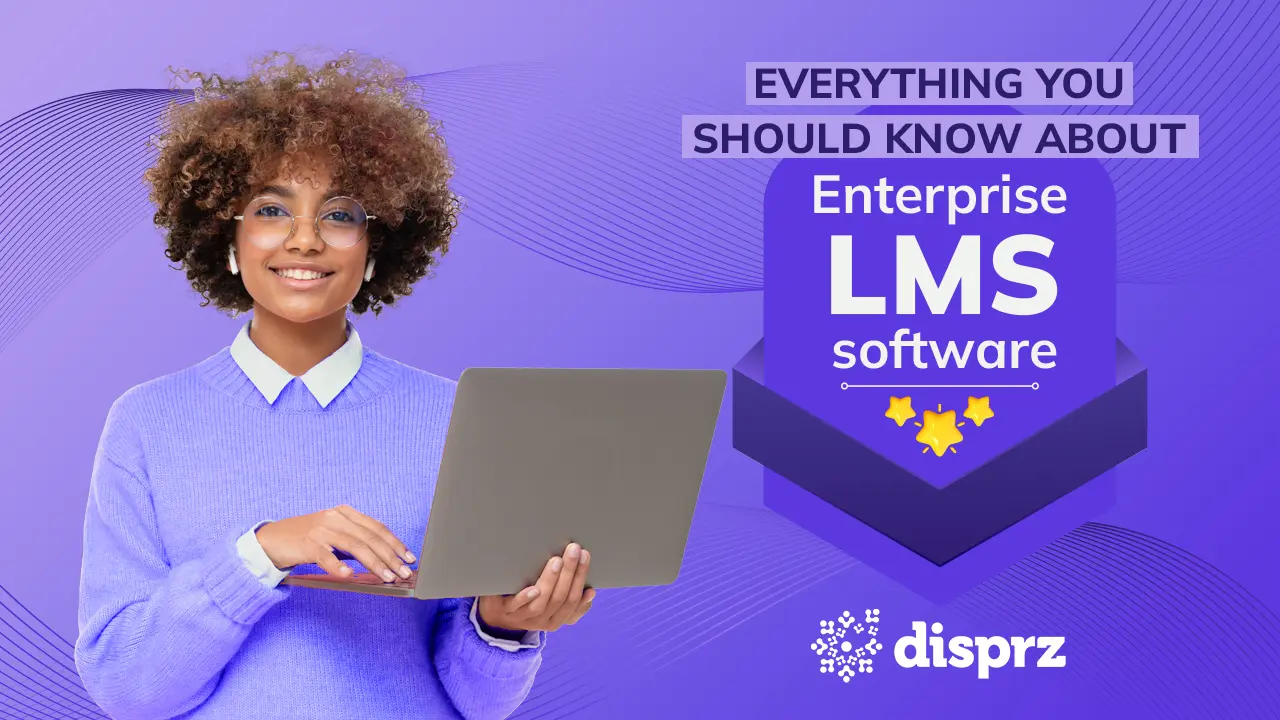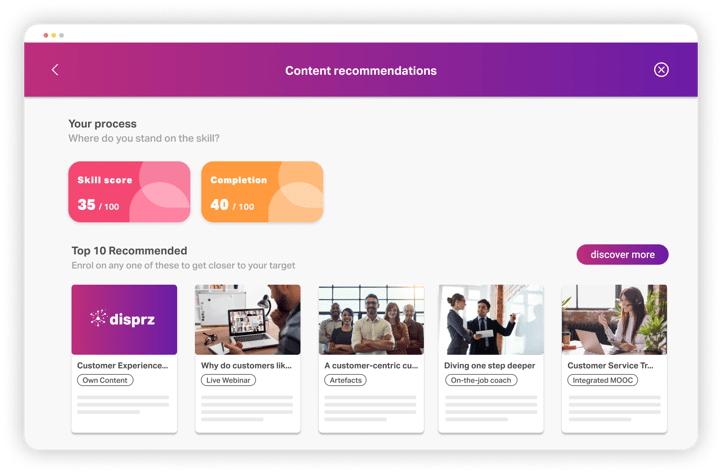
6 min read
• 26 Apr 2024
Learning Experience Platform 2024 - Guide for L&D Leaders
What is an LXP? Through a comprehensive guide, explore the revolutionary power of the Learning Experience Platform (LXP) in 2024 for employee upskilling.
-
eBookEmployee Upskilling - A Detailed Blueprint For Building A Skills-Driven Learning Culture
In the dynamic world of business, nurturing employee development is a necessity for organizational success. In fact, 91% of companies report that upskilling has significantly increased productivity in the workplace. But how do you ensure your corporate learning program will yield the business results you are looking to achieve?
Leveraging modern technology, like a Learning Experience Platform (LXP), enables you to revolutionize your employee learning initiatives. This powerful tool transforms your company’s approach to skill development and increases the likelihood of learning and development success.
Powered by artificial intelligence, an LXP enables the creation of tailored learning experiences for your employees. It streamlines the process of upskilling your workforce and expanding their expertise.
We explore the power of a Learning Experience Platform. We will unveil how these groundbreaking solutions can elevate productivity and foster employee engagement across your organization.
What is a Learning Experience Platform?
A Learning Experience Platform harnesses innovative technology to curate a wide range of learning resources, providing personalized learning experiences for employees. These solutions support skill-based learning, enabling you to:
-
Map skills to roles
-
Assess current skill levels and pinpoint skill gaps
-
Seamlessly address areas for improvement by determining the optimal learning path for each employee
Some L&D professionals think of this innovative technology as just another version of a learning management system. However, that is not correct. Let’s explore the differences between these two platforms.
LXP vs. LMS: What’s the Difference?
A Learning Management System (LMS) has traditionally been the go-to solution for enterprise learning platforms. While this platform has been successful in delivering and managing course content, it has limitations. These limitations include skills assessment, learning personalization, learning content curation, and engagement. These limitations can significantly impact the effectiveness of your learning programs.
As employee learning needs continue to evolve, the Learning Experience Platform has emerged as a more advanced alternative to the LMS.
Below are some of the most significant differences between LXP vs LMS.
Content curation - An LMS hosts organization-specific course content, while an LXP aggregates content from various sources. These sources include external content providers, in-house training materials, and user-generated content.
Personalization - Learning Experience Platforms utilize AI algorithms to personalize the learning experience. This includes recommending relevant content based on the learner’s interests, skill gaps, and learning history. An LMS lacks this level of personalization, as it relies on administrators to manually assign courses.
Skill-based learning - LXPs prioritize skill development that is relevant to an employee’s current role and career goals. While an LMS is more oriented towards delivering courses and tracking completion.
Continuous learning - An LXP offers easily accessible, on-demand content that employees can continuous learning consume at their own pace. An LMS follows a more structured, course-based learning approach with fixed schedules and learning deadlines.
User experience - An LXP prioritizes user experience. It is designed to resemble modern content platforms, making it more intuitive and engaging for your employees. While an LMS can be less user-friendly, its dated interface typically focuses on administration and task management.
Gain clarity on LXP vs LMS platforms and choose the best fit for your needs.
5 Must-Have Features of Best Learning Experience Platform 2024
When building your L&D program, there are a variety of learning solutions to choose from. However, not all of them are worth your organization’s time and investment. Your chosen learning experience platform must have the right features to be valuable and effective.
Here are the key features to consider when making your LXP platform selection:
-
Skill Repository
You must have access to a comprehensive skill repository to identify and map skills for every role in your organization. This repository will be instrumental in designing your upskilling program.

-
Content Creation and Curation
Your chosen solution must allow you to incorporate in-house programs and training. This feature lets you add customized training materials that your employees need, alongside curated content. -
Personalized Learning with AI-Based Content Recommendations
AI-based content recommendations enable you to implement personalized learning journeys. This feature ensures each learner has access to a range of training content and engages in a truly personalized learning experience.
-
Skill-Driven Career Progression
Your LXP must provide learning opportunities that enable your employees to improve skills directly related to their careers. This helps them thrive in their current and future roles within your company.
-
Learning Analytics and Reporting
You must have the ability to track employee platform usage, course completion, and learning progress. With the right analytics and reporting capabilities you can monitor the success of your L&D program and make strategic improvements.
The Benefits of Leveraging an LXP
Learning Experience Platforms have emerged as an indispensable tool to enhance employee engagement, scale learning programs, and reduce employee training costs. Let’s explore these benefits and more.
-
Enhanced employee engagement: Personalized learning experiences and diverse content offerings keep your employees engaged, motivated, and eager to learn. This increase in engagement results in higher retention rates.
-
Scalability: A Learning Experience Platform is designed to accommodate organizations of all sizes. This makes it easy to scale your learning programs as your company grows and evolves.
-
Increased knowledge retention: Offering microlearning experiences, LXPs help to improve knowledge retention and make learning more manageable for your workforce.
-
Cost-effectiveness: Centralizing learning resources and offering a wide range of learning content can help save on training costs.
-
Seamless learning ecosystem: An LXP can easily integrate with your existing systems and learning tools, such as HRMS and LMS. These integrations create a seamless learning ecosystem.
-
Future-proof workforce: Equip your employees with the skills to rapidly adapt to changing industry trends, market developments, and new skills required.
-
Internal Mobility: By enhancing their skills and knowledge, your employees can unlock new opportunities for career advancement within your organization.
Many organizations have benefited from leveraging an AI-powered LXP, including Petronas, an oil and gas company with 45,000 employees. Petronas was in need of a focused learning program for their C-suite executives. To make this program engaging and social for executives, they chose to partner with Disprz.
With our enterprise learning platform in place, Petronas provided role-based upskilling, microlearning, and mobile learning opportunities to their employees. They were also able to utilize social learning features to allow learners to interact with their peers and share knowledge. By leveraging the right tool, their learning program became a success and enabled Petronas to achieve 80% learning adoption and a 30% increase in employee engagement.
9 Best Practices to Successfully Implement an AI-powered Learning Experience Platform in 2024
As you’ve discovered, Learning Experience Platforms are reshaping employee development and paving the way for greater organizational success. However, implementing this learning tool effectively requires careful planning, collaboration, and strategic execution.
To ensure successful adoption within your organization, follow these best practices:
-
Establish clear objectives to guide the selection, implementation, and assessment of your LXP.
-
Engage your key stakeholders, including HR, management, IT, and even employees, in the decision-making and implementation processes.
-
Select the Learning Experience Platform that best meets your organization’s learning objectives and can be easily integrated into your existing systems.
-
Make use of AI-driven capabilities to create personalized learning paths for your employees. These paths will be based on their job roles, skill gaps, and interests.
-
Build a diverse content library tailored to your organization’s specific needs and goals.
-
Foster a learning culture for your organization by highlighting the importance of ongoing skill development and adaptability.
-
Offer employees the necessary support and resources to effectively utilize the LXP.
-
Clearly communicate the benefits of the platform to your employees to increase adoption and engagement with the platform.
-
Regularly assess learning analytics to identify areas of improvement and adjust your learning strategy accordingly.
Discover the Power of a Learning Experience Platform
Learning Experience Platforms have the power to revolutionize the way organizations approach employee skill development, fostering a culture of continuous learning and adaptability. This comprehensive guide has provided insights into the fundamental aspects of LXP solutions. These include the differences from traditional LMS solutions, essential features, benefits, and best practices.
By leveraging a Learning Experience Platform, you can unlock the full potential of your workforce, enhance employee engagement, and create a future-proof organization prepared to tackle the challenges of an ever-evolving business landscape. Request a demo to discover how Disprz can help you embrace this technology revolution and watch your organization soar to new heights.
About the author

disprz speaks
"Disprz Speaks" is the authoritative voice of Disprz, a prominent ecosystem dedicated to advancing enterprise skilling and learning. Our mission is to be your go-to resource for enlightening you with cutting-edge industry trends, narrate inspiring success stories, and provide valuable insights and strategies to empower your organization in today's dynamic business landscape.
More Resources
4 min read
• 15 Apr 2024
Unlocking the Power of Managerial Engagement in Talent Development
4 min read
• 09 Apr 2024
Nurturing Excellence in Building Leadership Pipelines
Sign up to get free resources and stay up to date with Disprz!
Discover how Disprz can align learning and upskilling with your desired business outcomes.






